Erato: Cooperative Data Story Editing via Fact Interpolation
Mengdi Sun, Ligan Cai, Weiwei Cui, Yanqiu Wu, Yang Shi, Nan Cao
View presentation:2022-10-20T19:12:00ZGMT-0600Change your timezone on the schedule page
2022-10-20T19:12:00Z

Prerecorded Talk
The live footage of the talk, including the Q&A, can be viewed on the session page, Storytelling.
Fast forward
Abstract
As an effective form of narrative visualization, visual data stories are widely used in data-driven storytelling to communicate complex insights and support data understanding. Although important, they are difficult to create, as a variety of interdisciplinary skills, such as data analysis and design, are required. In this work, we introduce Erato, a human-machine cooperative data story editing system, which allows users to generate insightful and fluent data stories together with the computer. Specifically, Erato only requires a number of keyframes provided by the user to briefly describe the topic and structure of a data story. Meanwhile, our system leverages a novel interpolation algorithm to help users insert intermediate frames between the keyframes to smooth the transition. We evaluated the effectiveness and usefulness of the Erato system via a series of evaluations including a Turing test, a controlled user study, a performance validation, and interviews with three expert users. The evaluation results showed that the proposed interpolation technique was able to generate coherent story content and help users create data stories more efficiently.